Special Canada Day !
The story of HMCS Bonaventure (“bonnie”), the only and only Canadian Navy Aircraft Carrier (1957-71), bedrock of the RCAN ASW duties within NATO after HMCS Warrior (1946-57). This was the ex-HMS Powerful, a Majestic class 1942 program light fleet carrier (described also as the second batch of the Colossus class), launched in February 1945, taking no part in WW2, nor commissioned in the RN. Instead as she was far from completion when the war ended, construction was halted and the hull was laid up and mothballed, with the government waiting for a potential customer to complete her. HMS Powerful was eventually purchased by the Royal Canadian Navy in 1952. Since technology made giant leaps since 1945, it was decided to complete her after full modernization, making her capable of operating modern jets. This process went from 1952 to 1957, and as completed she became the flagship of the RCAN until the great reforms and budget cuts of 1971.
Previous experience with aircraft carriers.
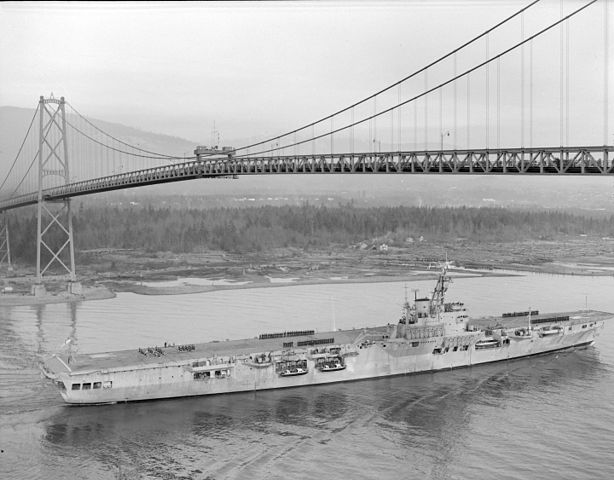
H.M.C.S. Warrior passing under the Lion’s Gate Bridge (1946-48)
There was already personal and airmen working for the RCN in WW2: Two escort aircraft carriers HMS Nabob and HMS Puncher of the Ruler class were manned entirely by Canadian personal, albeit under command and under flag of the RN. HMCS Warrior and HMCS Magnificent of the 1942 Design Light Fleet Carrier were planned to be acquired in 1944 so providing the RCN a solid way to help British efforts in the Pacific for the last stage of the war. But this was delayed for after the war.
Under lease, HMS Warrior was recommissioned as HMCS Warrior on 14 March 1946, but she was soon found to be unsuitable for the North Atlantic winter. She was returned in November 1948. Later resold to Argentina in 1959. The second, HMCS Magnificent, was not transferred at first for the same reasons. She was returned to the Royal Navy to be modernized and “winterized”, but loaned from 1948 until decommission in June 1957. “Maggie” was thus, the first Canadian aircraft carrier, but she was limited due to her lack of modernization, very much in her “WW2 juice” and only capable of operating piston-engine aircraft and helicopters. She went through a mutiny in the Carribean by 1949, and was present during the Suez crisis, carrying Canadian peackeeping troops and several Havilland Canada DHC-3 Otters and a single H04S helicopter. All along it was understood that a more modern carrier would be acquired.
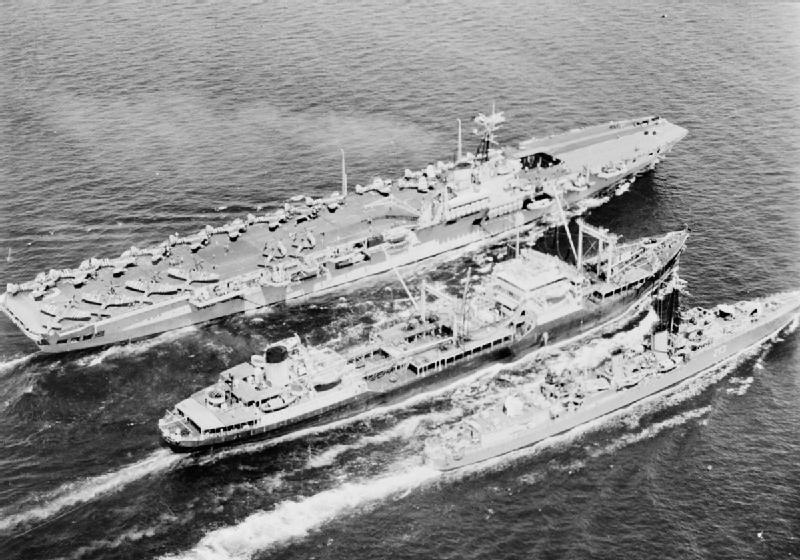
“Maggie” (HMCS Magnificient) and her escort HMCS Nootka under a RAS by HMCS Ocean off the coast of Korea, 1952.
This turned to be HMCS Bonaventure, former HMS Powerful, which was sold in 1952, completely modernized until 1952 (see later).
The British government indeed, having ordered a second hull of the Majestic class on 16 October 1942, when a new dock opened at Harland & Wolff’s shipyard (Belfast), her keel was laid down on 21 November 1943 in yard number 1229 whereas she was named Powerful and launched on 27 February 1945, but work suspended in May 1946, she waited for years for her fate before an agreement struck with the RCN in 1952 on the replacement for HMCS Magnificent, approved by the parliament on 23 April. Purchase cost was $21 million. The British Gvt. alternatively proposed also one of the most modern Hermes-class aircraft carrier in completion but this was found too costly. The US even proposed two Essex-class aircraft carriers on loan, but they were considered too large and costly again. Powerful’s choice was indeed solely out of cost considerations and financial support for the conversion (which kept workers busy by the new labor government).
So during the time the new carrier was under modernization (which was the most radical undertaken so far on any carrier of the class), five at greater cost than expected, its future personal trained hard on HMCS Magnificient. What was lacking of course was the capability of operating brand new jet aircraft and manage new electronics on the older carrier. This should be placed in the context of the time: Since 1947 and the start of the cold war, Canada was at the center of NATO (“north atlantic” organization), one of its pillar. It was expected the country, despite its already immense efforts consented to the allied cause during WW2, to still contribute in a significant manner against the expected mass of high-tech soviet submarines coming from the northern fleet.
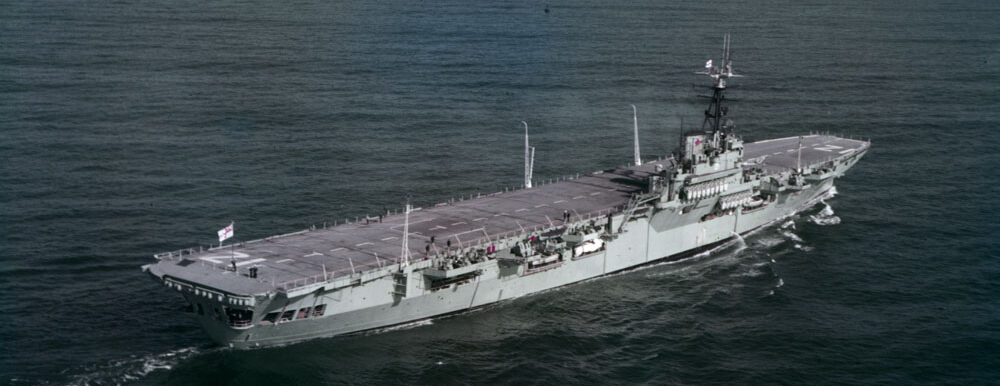
Design of the class
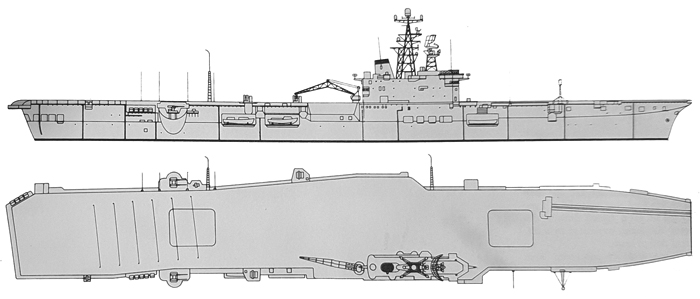
HMCS Bonaventure in her previous life was a typical Majestic class 1942 program light fleet carrier. I will not dwelve in detail on the peculiarities of the design, which were seen in detail in the base article, the Majestics (6 ships laid down 1943, launched 1944-45, completed postwar but one) mostly differed by a slightly larger displacement (14,000 versus 13,190t stadard), but they had reduced fuel and patrol stowage of 75,000 gallons to accomodate stronger decks and fittings to operate havier aircraft. This suited well future upgrades and postwar early jets. They saw service with India, Australia(2) and Canada(2), for the latter, Pagnificient and Powerful.
So this below will concentrate in the final result of a long conversion from 1952 to 1957.
Hull and general design
HMCS Bonaventure (RML 22) when was completed had a brand new angled deck but her radar and armament were supplied from the United States. Although similar to her sisters she had a distinctive appearance with a tall British built lattice mast similar to most modernized RN ships, and a raked funnel, plus a big sponson for her twin 3in AA guns.
After modernization she also displaced 16,000 long tons (16,257 t) standard instead of 14,000 (2,000 tonnes more) for 20,000 long tons (20,321 t) fully loaded.
Her waterline lenght was unchanged at 629.9 ft (192.0 m) but she was slightmy extended by the TO outrigger ramp at 704 ft (215 m) instead of 695 ft (211.8 m). The flight deck shape was completely changed, widened at the flight deck level, so she kept her waterline beam of 79.9 ft (24.4 m) but jumped to 112.5 ft (34.3 m) at the deck’s widest section, instead of 80 ft (24.4 m). The draught also increased to 24.5 ft (7.5 m) instead of 23 ft (7.01 m deep load).
Armour protection layout
The original ships had kept their original armor of 190 mm (7.4 in) for the main deck under the hangar. The upper deck was also further reinforced and strenghtened with internal bracing in the hangar. The underwater compartimentation was kept unchanged. The machinery spaces were divided between four turbine rooms, four boiler rooms, and two main auxilary power units and generators (APU).
It seems her avgas were not protected, just enlarged and buried deeper, while armored mantlets were fitted over the magazines.
Powerplant
HMCS “Bonnie” kept her original powerplant, which was unused at the time and at the top of clasic steam turbine machinery at the time. This consisted in her original two shaft Parsons single-reduction geared steam turbines coupled with four Admiralty 3-drum type 350 psi (2.4 MPa) boilers for a total output of 40,000 shp (30,000 kW). Top speed was 24.5 knots (45.4 km/h). Range was probably comparable to the orignal ships, circa 12,000 nautical miles at 14 knots with 3,000 tons oil bunkerage.
Armament
As first planned she was to have nineteen single sponsons 40mm/60 Mk III Bofors and six quad 40mm/39 Mk VII Pompom around her island. And her initial air group of 37 aicraft. Of course this all went though the windows. In lieu in 1957 she was completed by a more potent artillery to deal with jets, US-supplied:
-Four 3 in (76 mm)/50 Mark 33 twin-mounted guns, in place of the intended pompom, as a one to one basis (details and specs here)
-Eight single Bofors 40 mm guns in some of the same sponsons as before. Arguably not the most impressive part, but with upgraded fire control.
She also had four 3pdr saluting guns and an air group reduced to 21-24 aircraft (see later).
Sensors
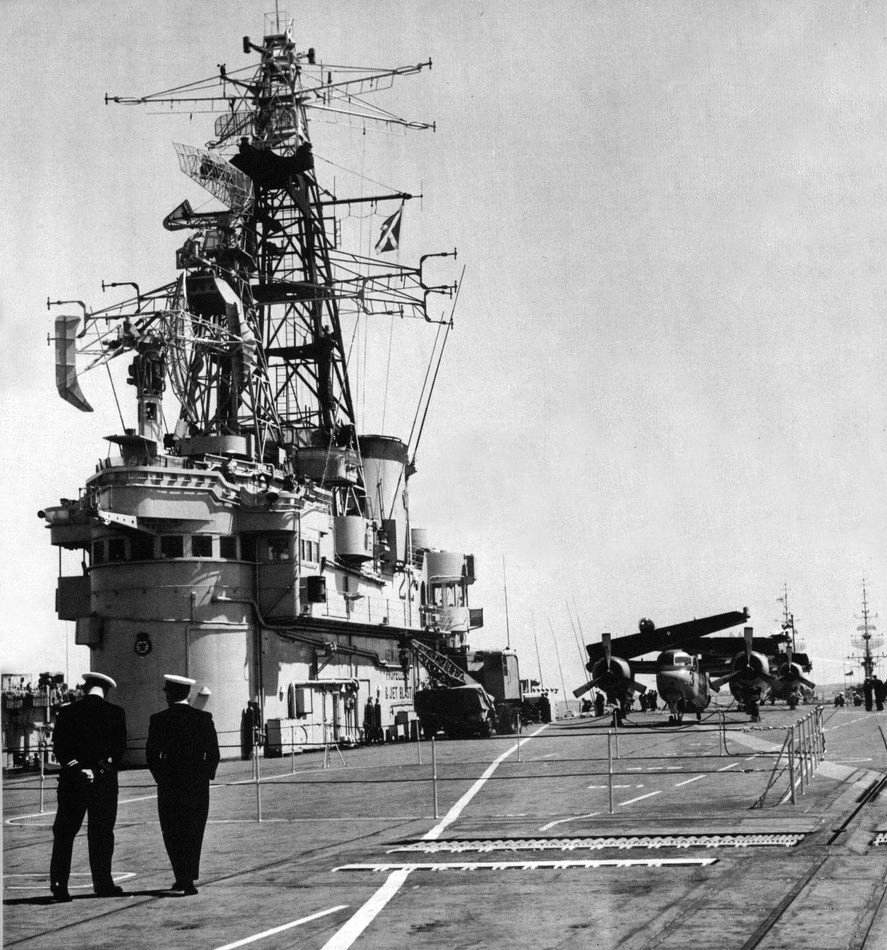
As planned for completion in 1945 she was to have a type 79B and two type 281B radars, plus a type 144 sonar. In 1957 however this have been changed completely for modern US standards electronics, and she carried the following:
AN/SPS-10 surface search
AN/SPS-12 air search
AN/SPS-8 height finder
Air group & Facilities of HMCS Bonaventure
Initially she had a flight deck measuring 5,131m², and a hangar 2,142m² or 11,355m³ in volume. The two lifts mesured 16.5 x 10.4m and for 7 tons and this was completed by a catapult BH-III (6.4t plane launched at 122 km/h) and a fuel stowage of 341,000 liters.
Bonaventure improved all previous limits by enabling aicraft up to 24,000 pounds (11,000 kg) to land, and be operated on her lifts or catapulted. The aircraft lifts indeed were enlarged to 54 by 34 feet (16 m × 10 m). In addition to her angled flight deck, she had stronger steam catapults and the latest optical landing system. The angled flight deck consisted in just a sponsoned starboard extension which increased the landing area massively by a simple use of deck paint, creating an oblique aopproach pattern, without limiting too much available parking space not impending launching operations. The antiquated crash barriers were removed.
The original air group consisted of sixteen F-2H Banshee fighters and eight S-2F Tracker ASW aircraft, but it was subsequently changed to an entirely ASW mission with eight Trackers and thirteen HO4S-3 Whirlwind helicopters, and in time the Whirlwinds gave way to CHSS-2 Sea King helicopters. During her 1966-67 modernisation, the ship was given new radars and improved accommodation and aircraft handling, whereas the two forward 3in gun mountings were removed to save weight. The new radars were the Dutch Signaal type. The ship’s designation changed twice, to RRSM 22 in 1957, then to CVL 22, and she carried the number ’22’ for deck recoignition.
The Canadian Banshee
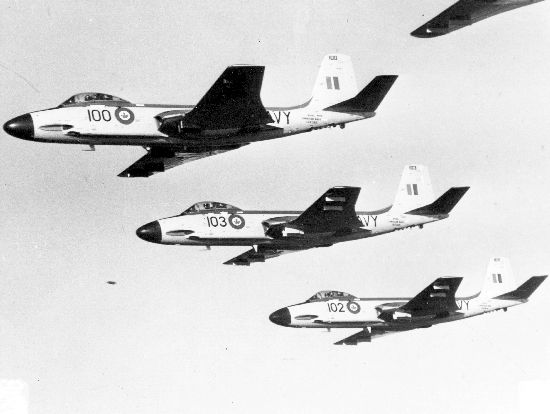
Three Royal Canadian Navy McDonnell Banshee fighters in flight
In 1951, the Royal Canadian Navy (RCN) drafted a $40 million deal for 60 new Banshees to replace obsolete Hawker Sea Furies. However the purchase was not approved by the Parliament until after Banshee production had ended in 1953 and then greenlight 39 second-hand US Navy F2H-3s for $25 million, delivered from 1955 to 1958, flown from HMCS Bonaventure and equipped in time with AIM-9 Sidewinder missiles, trialled in November 1959. Canadian pilots like the Banshee’s handings but 12 of its original 39 were still lost to accidents (30.8%) after various issues. One was lost after an inflight failure of the folding wing mechanism for example, another a brake failure when landing. There was also the training “normal” attrition with the usual crash-landings.
The Banshee were removed from service when the RCN focused solely to ASW and in addition the acquisition for this of the much larger Grumman CS2F Trackers for around-the-clock ASW patrols left little room for the fighter, still operating from land bases though. Budget cust finally drive the Banshees out of carrier and overall service and they were retired without replacement by September 1962. Still, some went on with the RCN Grey Ghosts aerobatic team.
Construction
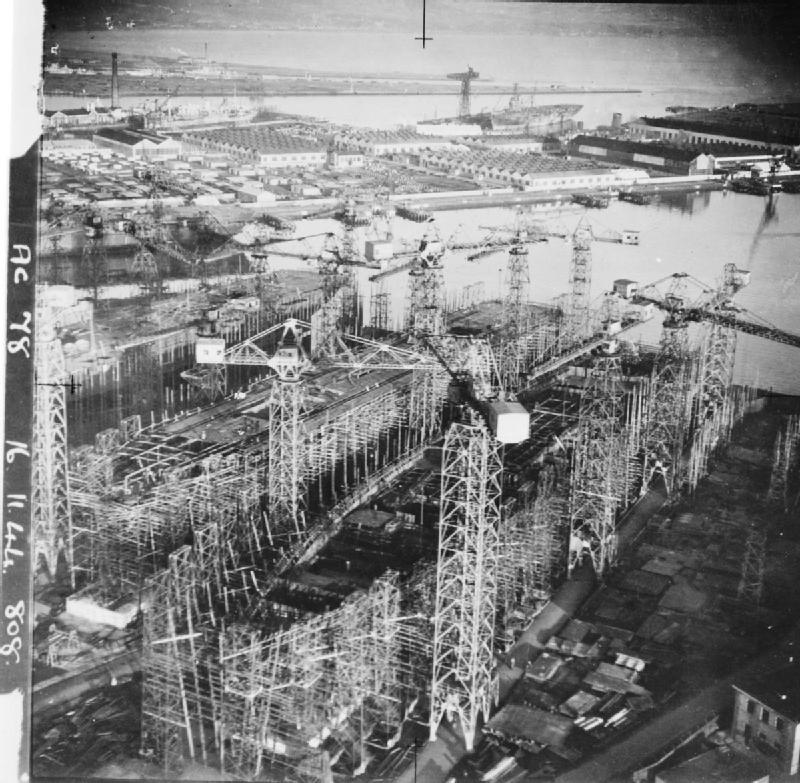
Agreement on the purchase of Powerful was reached on 29 November, back-dated for 12 July and Work on HMS Powerful resumed to the new modernized design, made by incorporating recent British (and US) carrier operation developments. The angled flight deck and steam catapults were all adapted to jet operations. These design added to the purchase cost a further $10 million. Other changes incorporated the finally chosen American radar and armament. Completion was effective by 17 January 1957, for a commission into the Royal Canadian Navy whilst at Belfast. She was renamed Bonaventure with Captain H.V. Gross in command, christened at Belfast by the wife of the Canadian Minister of National Defence, Ralph Campney. The name chosen was after the Bonaventure Island, a bird sanctuary in the Gulf of St. Lawrence, which was popularly associated with marine birds. It was an old French Canadian word meaning “good adventure” but can be also translated for the time as “godspeed”. For sailors -especially west anglophones strugging with her name- it was always “bonnie”. When homeported at Halifax, Nova Scotia, she adopted the motto “Nos toz seus (Not for us alone)”.
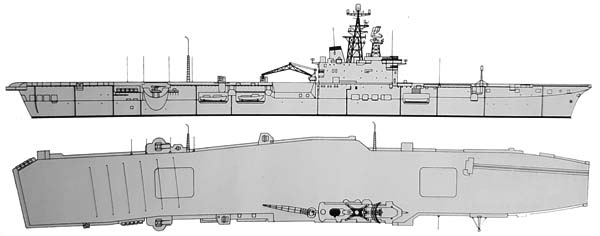
Conway’s 2 views blueprint showing notably her new masts and angled flight deck.
⚙ specifications |
|
| Displacement | 16,000 T standard, 20,000 tonnes FL |
| Dimensions | 214.6 x 39 x 7.6 m (704 x 128 x 25 fts) |
| Propulsion | 2 shafts geared steam turbines, 4 admiralty boilers, 40,000 shp |
| Speed | 24.5 knots (45.4 km/h) |
| Range | Oil 3,200 tons, circa 12,000 nm/10 kts |
| Armament | 4×2 3in/50, 4x 3pdr saluting, 21-24 aircraft |
| Sensors | SPS-8A, SPS-12 |
| Crew | 1370 |
Career of HMCS Bonaventure 1957-1971
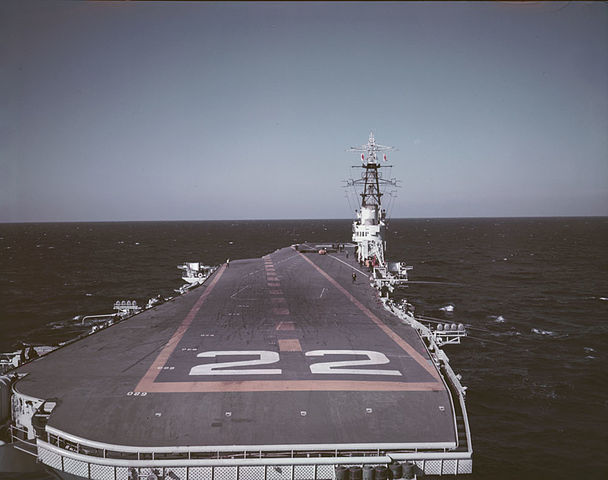
HMS Bonaventure’s flight deck in 1957
HMS Bonaventure started her sea trials in March 1957, with a doctrine of convoy escort. She began trials in the English Channel with her aircraft group and sailed for Canada on 19 June to Halifax, Nova Scotia, her new home port from 26 June. She carried also the experimental hydrofoil Bras d’Or to on her flight deck.
In October, she made more with her air qualified group VF-870 (Banshee), VS-881 (S2 Tracker) and single HO4-S helicopter, in the Caribbean Sea until early 1958. She also made there cross-deck operations with HMS Bulwark.
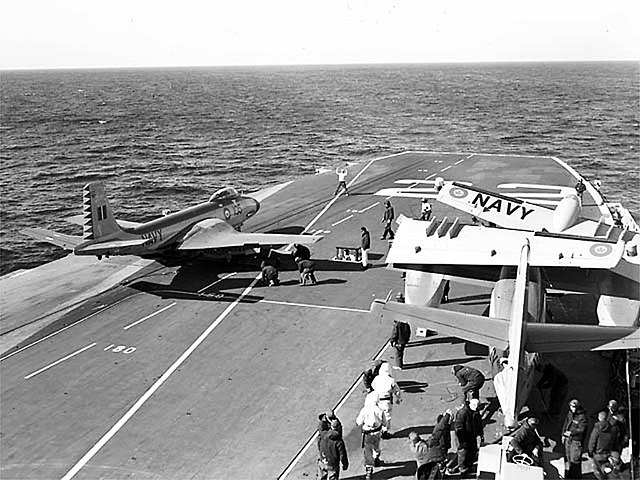
Banshee being catapulted in 1957
On 2 October, a first Banshee flying to NS HMCS Shearwater was lost, one of many. They were never found. While under Captain William Landymore (15 January 1958) there was a fatal crash on 25 February 1958 after takeoff. On 4 March, this was a brake failure and overshoot. In mi-1958 she took part in naval exercises New Broom IX and Sharp Squall IV, in which she lost another Banshee during takeoff, pilot recovered by HMCS Athabaskan.
In November 1958, while off the Grand Banks, Newfoundland, she made contact with a Soviet Navy submarine close to suspitious Russian fishing trawlers. She lade a cruise to UK and when back stopped at Saint John, New Brunswick. On 12 September 1959 Captain John O’Brien took command but by 1960, NATO reorganization meant Canadian contribution was now to constitute an ASW hunter-killer group.
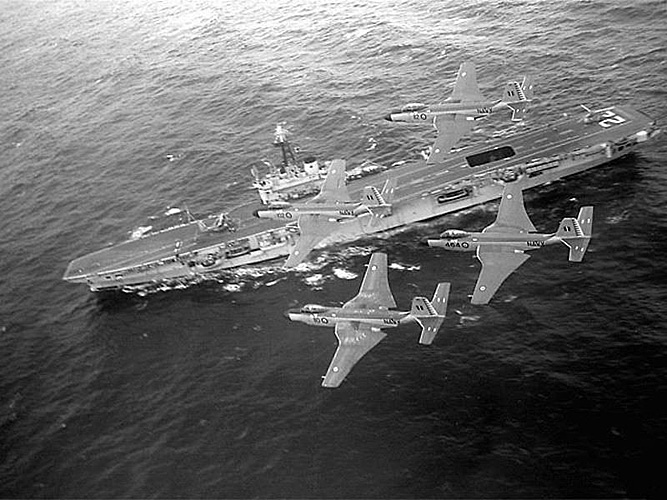
A flight of Banshees above “Bonnie” in 1958.
This was done and by November 1960 she still carried VF-870 (Banshee, but less planes) and VS 880 (S2 Tracker) plus a larger HS 50 (HO4-S) helicopter squadron. From February 1961 she was at the exercise Toput Droit, and trained with the US Atlantic Fleet this summer and until October. Captain F.C. Frewer took command on 30 August 1961 and by April 1962 she fested her 10,000th deck landing. On 30 September 1962 the Banshee was withdrawn for good. Her mission became purely ASW with only trackers and helicopters, VS 880 and HS 50.
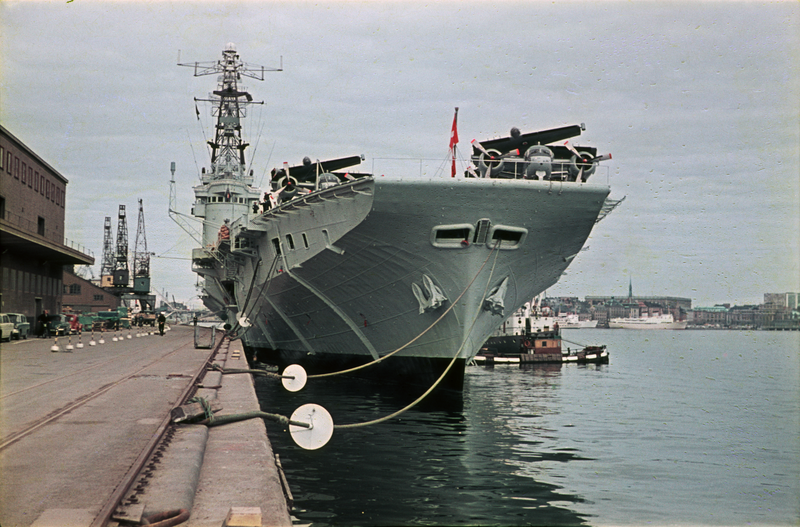
Moored in June 1960
On 13 October 1962, just before the Cuban Missile Crisis, Bonaventure was off UK and she was recalled to Canada, homeport. From January 1963 she sailed to Saint John for a refit to modify the newly arrived Sea King helicopter. She restarted operations by May, but had be to be repaured after a boiler explosion while in Halifax, delaying it by six weeks. On 7 August Captain Robert Timbrell took command and she took part in exercize Sharp Squall and testing the GIUK gap (Greenland-Iceland gap). She also made cross-deck operations with HNLMS Karel Doorman acting in the same role (and same type carrier).
Mid-life refit and late life
The 1964 Navy estimates called for a major refit of Bonaventure to prolongate her service life and when it was planned she took part in exercise Gooey Duck off Bermuda in January and in February and ending in the Mediterranean Sea. She was recalled to embark troops from the Canadian Royal 22nd Regiment as UN peacekeeping Operation Snow Goose. The 95 soldiers, 54 vehicles and 400 tons of stores were landed at Famagusta, Cyprus dyring the crisis on 30 March. Back to Canada she stopped at Norfolk to test the latest A-4 Skyhawk for a possible acquisition which was dropped due to financial cuts. Instead she completed sea sea trials with the Sea King.
In January 1965, her air group was still VS 880 (Tracker) and HS 50 (Sea King) but she has also a single HO4S plane guard (detached from HU 21 squadron) and COD (carrier onboard delivery) cargo Tracker (VU 32 squadron). In February-March 1965, she had two exercises, in May she was in UK, and by 2 April 1965 changed CO, to Henry Porter, while in June she landed at the Londonderry Joint Anti-Submarine School for joint training on the Southwest Approaches, with HMS Ark Royal, and HNLMS Karel Doorman.
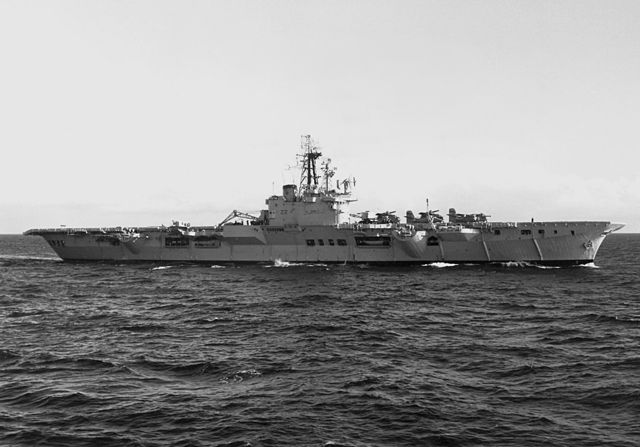
Underway in 1961
By January 1966 with six escorts she made a large ASW deployment in the Caribbean Sea and South America, stopping at Rio de Janeiro in February by March. By April at last she underwent her mid-life refit at Davie Shipbuildingn Lauzon, Quebec. The initial $8 million went to $17 However due to old issues plus usual cost overruns and delays, for 18 months, over on August 1967. Captain A. T. Brice from August supervised her recommission complete by November 1967, this time under R. H. Falls.
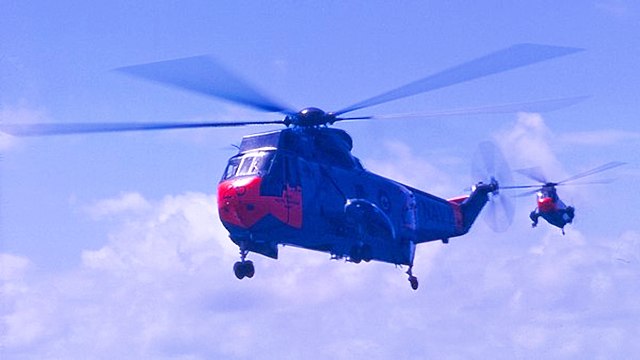
Two CH-124 Sea Kings approach Bonaventure in February 1968
The 1968 Unification of the Canadian Forces called for drastic reorganization. The RCN no longer existed and Bonaventure as her naval aviation in the Canadian Armed Forces now supervised in part by aviation cadree. By February 1968, she lost a Sea King during another exercize and both the crew was saved and the crew salvaged as it managed to stay afloat until being found. This only reinforced the good opinions about the Sea King, only replaced recently by the EH-101 long after the carrier’s decommission. In March Bonaventure visited New Orleans, followed by two months of exercises. And the next year she trained with the USN, took part in Peace Keeper off Ireland.
On 9 April 1969 J. M. Cutts took command and she returned to UK, stopping at Portsmouth, and back to HP Halifax on October 1969. In a spree of budget cuts the government wanted Bonaventure declared surplus. Her lask deck landing was in the night of 28 October and last deck landing on 12 December 1969 off Boston.
On January 1970 under H. W. Vondette she carried the Royal 22nd Regiment to Jamaica for training. In February, she replenished frigates during Exercise Maple Spring whith still six Sea Kings aboard. In April she went to Narvik in Norway, embarking Canadian troops after their winter exercise, stoping at Portsmouth on her way back.
After arrival at Halifax, “Bonnie” was eventually decommissioned on 3 July 1970, sold for BU. After a call to tender she was purchased by Tung Chen S Steel Company, Taiwan. She was towed there and scrapped in 1971 but her steam catapult was saved and went to the Australia ncarrier HMAS Melbourne, compatible.
Her anchors were preserved also, now at Point Pleasant Park, Halifax (Bonaventure Anchor Memorial) in 1973 and the other, donated on 6 May 1998 is now at Royal Military College Saint-Jean, and her two saluting guns now on HMCS Discovery, Vancouver’s Stanley Park. Her bell was saved too, now at Shearwater Aviation Museum in Dartmouth, Nova Scotia, and in the same room is visible a large model of the carrier.
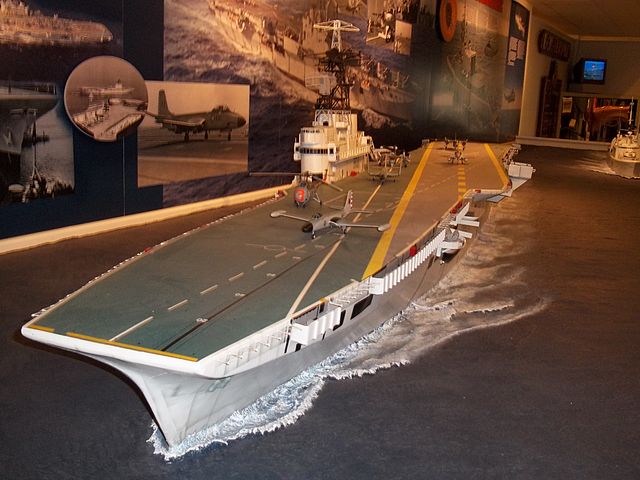
Model of the carrier at Shearwater
Read More
Books
Arbuckle, J. Graeme (1987). Badges of the Canadian Navy. Halifax, Nova Scotia: Nimbus Publishing
Beaver, Paul (1982). The British Aircraft Carrier. Cambridge, UK: Patrick Stephens.
Blackman, Raymond V. B., ed. (1953). Jane’s Fighting Ships 1953–54. London: Sampson, Low and Marston.
Boutiller, James A., ed. (1982). RCN in Retrospect, 1910–1968. Vancouver: University of British Columbia Press.
Brown, David K.; Moore, George (2012). Rebuilding the Royal Navy: Warship Design since 1945. Barnsley, United Kingdom: Seaforth Publishing
Gardiner, Robert; Chumbley, Stephen; Budzbon, Przemysław, eds. (1995). Conway’s All the World’s Fighting Ships 1947–1995. NIP
Hall, Timothy (1982). HMAS Melbourne. North Sydney, NSW: George Allen & Unwin.
Hobbs, David (2013). British Aircraft Carriers: Design, Development and Service Histories. Seaforth Publishing.
Kealy, J. D. F.; Russell, E. C. (1967). A History of Canadian Naval Aviation 1918–1962. Queen’s Printer
Macpherson, Ken; Barrie, Ron (2002). The Ships of Canada’s Naval Forces 1910–2002 (Third ed.). Vanwell Publishing.
Milner, Marc (2010). Canada’s Navy: The First Century (Second ed.). University of Toronto Press.
Tracy, Nicholas (2012). A Two-Edged Sword: The Navy as an Instrument of Canadian Foreign Policy. McGill-Queens University Press.
Links
fleetairarmarchive.net POWERFUL.html
on seaforces.org/
canada.ca/ bonaventure.html
forposterityssake.ca
navalandmilitarymuseum.org/
valourcanada.ca
cbc.ca
on canada.ca
en.wikipedia.org
on navypedia.org the “majestic” class
pinterest.co.uk/ photo board on bonnie
on warmuseum.ca/
warmuseum.ca/ gallery 2
on militaryfactory.com
on readyayeready.com/
on archives.novascotia.ca/
on main.lib.umanitoba.ca/
on veterans.gc.ca/ anchor memorial
on facebook.com/
on seaforces.org/
on cbc.ca/ hmcs-bonaventure-remembered
Videos
Model Kits
No model but this scratchbuilt one from a colossus-class 1:700 kit. See the colossus class page for more kits. Her air group was also covered, between the banshee and HO4S-3 and CS-2F (CP-121) “Tracker”.


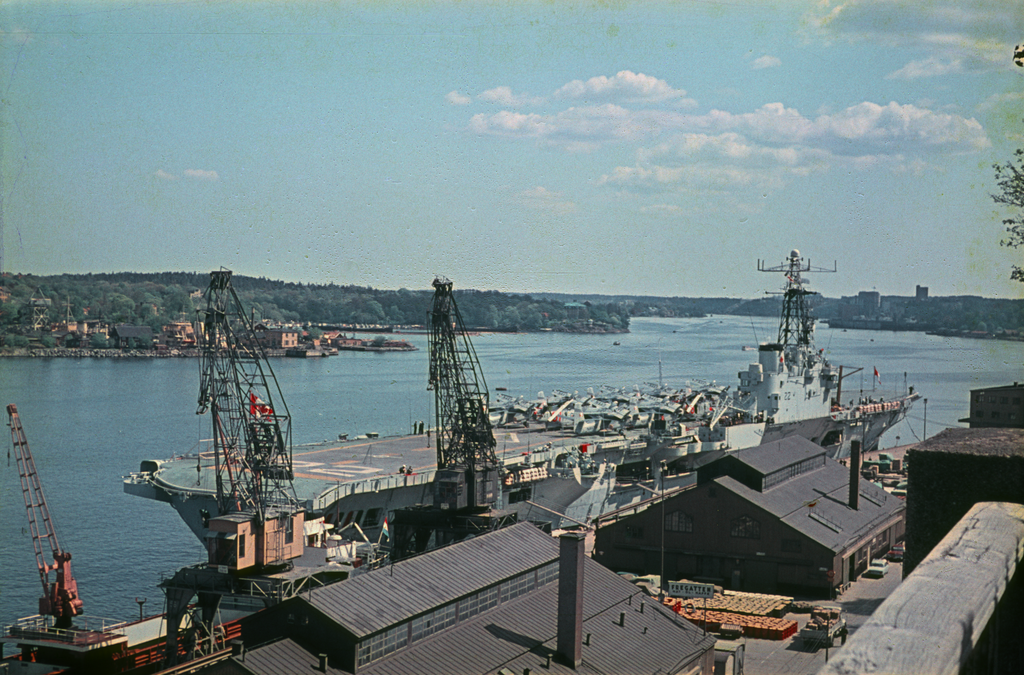
 Latest Facebook Entry -
Latest Facebook Entry -  X(Tweeter) Naval Encyclopedia's deck archive
X(Tweeter) Naval Encyclopedia's deck archive Instagram (@navalencyc)
Instagram (@navalencyc)





 French Navy
French Navy Royal Navy
Royal Navy Russian Navy
Russian Navy Armada Espanola
Armada Espanola Austrian Navy
Austrian Navy K.u.K. Kriegsmarine
K.u.K. Kriegsmarine Dansk Marine
Dansk Marine Nautiko Hellenon
Nautiko Hellenon Koninklije Marine 1870
Koninklije Marine 1870 Marinha do Brasil
Marinha do Brasil Osmanlı Donanması
Osmanlı Donanması Marina Do Peru
Marina Do Peru Marinha do Portugal
Marinha do Portugal Regia Marina 1870
Regia Marina 1870 Nihhon Kaigun 1870
Nihhon Kaigun 1870 Preußische Marine 1870
Preußische Marine 1870 Russkiy Flot 1870
Russkiy Flot 1870 Svenska marinen
Svenska marinen Søværnet
Søværnet Union Navy
Union Navy Confederate Navy
Confederate Navy Armada de Argentina
Armada de Argentina Imperial Chinese Navy
Imperial Chinese Navy Marinha do Portugal
Marinha do Portugal Mexico
Mexico Kaiserliche Marine
Kaiserliche Marine 1898 US Navy
1898 US Navy Sovietskiy Flot
Sovietskiy Flot Royal Canadian Navy
Royal Canadian Navy Royal Australian Navy
Royal Australian Navy RNZN Fleet
RNZN Fleet Chinese Navy 1937
Chinese Navy 1937 Kriegsmarine
Kriegsmarine Chilean Navy
Chilean Navy Danish Navy
Danish Navy Finnish Navy
Finnish Navy Hellenic Navy
Hellenic Navy Polish Navy
Polish Navy Romanian Navy
Romanian Navy Turkish Navy
Turkish Navy Royal Yugoslav Navy
Royal Yugoslav Navy Royal Thai Navy
Royal Thai Navy Minor Navies
Minor Navies Albania
Albania Austria
Austria Belgium
Belgium Columbia
Columbia Costa Rica
Costa Rica Cuba
Cuba Czechoslovakia
Czechoslovakia Dominican Republic
Dominican Republic Haiti
Haiti Hungary
Hungary Honduras
Honduras Estonia
Estonia Iceland
Iceland Eire
Eire Equador
Equador Iran
Iran Iraq
Iraq Latvia
Latvia Liberia
Liberia Lithuania
Lithuania Mandchukuo
Mandchukuo Morocco
Morocco Nicaragua
Nicaragua Persia
Persia San Salvador
San Salvador Sarawak
Sarawak Uruguay
Uruguay Venezuela
Venezuela Zanzibar
Zanzibar Warsaw Pact Navies
Warsaw Pact Navies Bulgaria
Bulgaria Hungary
Hungary

 Bundesmarine
Bundesmarine Dutch Navy
Dutch Navy Hellenic Navy
Hellenic Navy Marina Militare
Marina Militare Yugoslav Navy
Yugoslav Navy Chinese Navy
Chinese Navy Indian Navy
Indian Navy Indonesian Navy
Indonesian Navy JMSDF
JMSDF North Korean Navy
North Korean Navy Pakistani Navy
Pakistani Navy Philippines Navy
Philippines Navy ROKN
ROKN Rep. of Singapore Navy
Rep. of Singapore Navy Taiwanese Navy
Taiwanese Navy IDF Navy
IDF Navy Saudi Navy
Saudi Navy Royal New Zealand Navy
Royal New Zealand Navy Egyptian Navy
Egyptian Navy South African Navy
South African Navy






























 Ukrainian Navy
Ukrainian Navy dbodesign
dbodesign